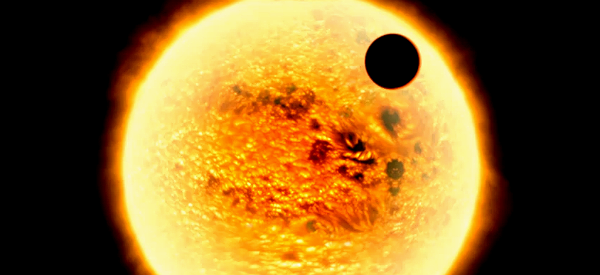Measuring a distant planet’s transit (The Exoplant Transit Method)

Astronomers first discovered evidence of a new planet outside of our solar system in 1995. Since then astronomers have discovered 529 other planets. These planets outside our solar system, referred to as extra-solar planets or in short exoplanets, have been detected using many different methods.
Transits, which cause dips in a star’s light, are minuscule compared to the brightness of the star, and challenging to detect. For an Earth-size planet transiting a Sun-like star the change in brightness is only 84 parts per million (ppm). That is less than 1/100th of 1%. For a Jupiter-size planet, the transit causes the star light to dip 1 to 2%. The size of the effect for an Earth is similar to the dimming one might see if a flea were to crawl across a cars headlight viewed from several miles away.
The Kepler Mission is designed to detect planets as they transit (pass in front of) their stars which causes a tiny dip in the star’s light.
The discovery of a planet is confirmed by observing several transits that have the same depth (dip in star light), duration (time to transit the star), and period (same amount of time between successive transits). A single event that looks like a transit is not enough. It must be confirmed by observing repeated transits.
Credit: Dana Berry
The Exoplanet Transit Method
The transit method is only one of many methods astronomers use to discover an exoplanet. A transiting exoplanet is a planet which passes in front of the host star as seen from Earth. The orbit of an exoplanet may vary a lot, in terms of orbital distance and inclination.
When exoplanet transits, a portion of the light from the star is blocked out and a decrease in the number of photons is measured. Measuring the photon number or photon flux over time allows astronomers to make what is known as a light curve. Assuming the star is of uniform brightness, the change in flux will depend on both the radius of the exoplanet, and the radius of the star. If the radius of the host star is known, one also knows the radius of the planet.
Astronomers can estimate the inclination of the exoplanet orbit depending on how the exoplanet crosses the host star.
From a method known as the Radial velocity method, one has an expression for what is known as the minimum mass. Knowing the inclination of the exoplanet orbit and knowing the minimum mass, one can calculate the mass of the exoplanet itself, assuming the stellar mass is known.
Having an estimate of both the radius and the mass of the exoplanet, one can easily calculate the average density. With an average density astronomers can estimate what sort of planet it is. If the planet is a gasseous planet like Saturn or Jupiter or rocky like our own Earth.
Credit: Paul Anthony Wilson
Since the last Kepler catalog was released in February 2012, the number of candidates discovered in the Kepler data has increased by 20 percent and now totals 2,740 potential planets orbiting 2,036 stars. The most dramatic increases are seen in the number of Earth-size and super Earth-size candidates discovered, which grew by 43 and 21 percent respectively. The new data increases the number of stars discovered to have more than one planet candidate from 365 to 467. Today, 43 percent of Kepler’s planet candidates are observed to have neighbor planets.
At the beginning of 2012, 33 candidates in the Kepler data had been confirmed as planets. Today, there are 105.
The complete list of Kepler planet candidates is available in an interactive table at the NASA Exoplanet Archive.

[…] of exoplanets obscured by exponentially bright stars. Unlike Kepler mission which uses the transit method to find out exoplanets transiting in front of their stars, this one actually blots out bright […]